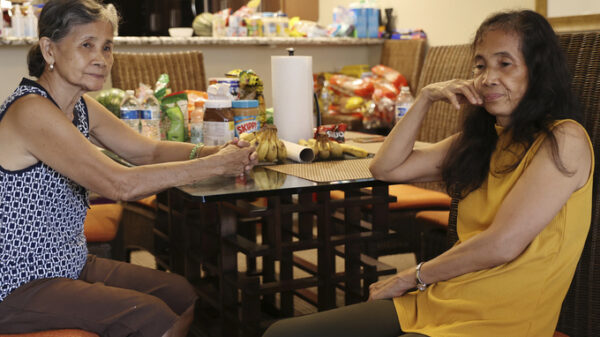A member of the Ukrainian Emergency Service looks at the City Hall building in the central square following shelling in Kharkiv, Ukraine, Tuesday, March 1, 2022. Russian strikes pounded the central square in Ukraine’s second-largest city and other civilian sites Tuesday in what the country’s president condemned as blatant campaign of terror by Moscow. (AP Photo/Pavel Dorogoy)
KYIV, Ukraine (AP) — Russian forces bombarded the central square in Ukraine’s second-largest city and other civilian sites Tuesday in what the country’s president condemned as a blatant campaign of terror by Moscow. “Nobody will forgive. Nobody will forget,” vowed President Volodymyr Zelenskyy.
At the same time, a 40-mile (64-kilometer) convoy of hundreds of Russian tanks and other vehicles advanced on the capital, Kyiv, in what the West feared was a bid to topple Ukraine’s government and install a Kremlin-friendly regime. And Russian President Vladimir Putin’s forces pressed their attack on other towns and cities across the country, including at or near the strategic ports of Odesa and Mariupol in the south.
Day 6 of the biggest ground war in Europe since World War II found Russia increasingly isolated, beset by tough sanctions that have thrown its economy into turmoil and left the country practically friendless, apart from a few nations like China, Belarus and North Korea.
In Kharkiv, Ukraine’s second-biggest city, with a population of about 1.5 million, at least six people were killed when the region’s Soviet-era administrative building was hit. Explosions tore through residential areas, and a maternity ward was moved to an underground shelter.
Kharkiv’s Freedom Square — Ukraine’s largest plaza, and the nucleus of public life for the city — was struck with what was believed to be a missile, in an attack seen by many Ukrainians as brazen evidence that the Russian invasion wasn’t just about hitting military targets but also about breaking their spirits.
The bombardment blew out windows and walls of buildings that ring the massive central square, which was piled high with debris and dust. Inside one building, chunks of plaster were scattered, and doors, ripped from their hinges, lay across hallways.
“People are under the ruins. We have pulled out bodies,” said Yevhen Vasylenko, a representative of the Emergency Situations Ministry in Kharkiv region. In addition to the six killed, 20 were wounded in the strike, he said.
Zelenskyy pronounced the attack on the main square “frank, undisguised terror,” blaming a Russian missile and calling it a war crime. “This is state terrorism of the Russian Federation,” he said.
In an emotional appeal to the European Parliament later, Zelenskyy said: “We are fighting also to be equal members of Europe. I believe that today we are showing everybody that is what we are.”
He said 16 children had been killed around Ukraine on Monday, and he mocked Russia’s claim that it is going after only military targets.
“Where are the children, what kind of military factories do they work at? What tanks are they going at, launching cruise missiles?” Zelenskyy said.
In a worrying development, Human Rights Watch said it documented a cluster bomb attack outside a hospital in Ukraine’s east in recent days. Local residents also reported the use of the weapons in Kharkiv and the village of Kiyanka, though there was no independent confirmation.
If confirmed, that would represent a worrying new level of brutality in the war and could lead to even further isolation of Russia.
The Kremlin denied it has used such weapons.
Many military experts worry that Russia may be shifting tactics in Ukraine. Moscow has a long history in Chechnya and Syria of using massive artillery and air bombardments to pulverize cities and crush fighters’ resolve.
The International Criminal Court’s chief prosecutor said he plans to open an investigation into possible war crimes in the invasion.
Unbowed by Western condemnation, Russian officials upped their threats of escalation, days after raising the specter of a nuclear attack. A top Kremlin official warned that the West’s “economic war” against Russia could turn into a “real one.”
The first talks Monday between an outgunned Ukraine and nuclear-armed Russia yielded no stop in the fighting, though the two sides agreed to another meeting in the coming days.
Throughout the country, many Ukrainian civilians spent another night huddled in shelters, basements or corridors. More than a half-million people have fled the country, and the U.N. human rights office said it has recorded the deaths of 136 civilians. The real toll is believed to be far higher.
“It is a nightmare, and it seizes you from the inside very strongly. This cannot be explained with words,” said Kharkiv resident Ekaterina Babenko, taking shelter in a basement with neighbors for a fifth straight day. “We have small children, elderly people and frankly speaking it is very frightening.”
Russian strikes on Mariupol seriously wounded several people Tuesday, and at a checkpoint outside the Black Sea city of Odesa, the body of a man lay sprawled on a highway next a car whose back seat was covered in blood.
A Ukrainian military official said Belarusian troops joined the war Tuesday in the Chernihiv region in the north, without providing details. But just before that, Belarusian President Alexander Lukashenko said his country had no plans to join the fight.
In Kharkiv, explosions burst one after another through a residential area in a video verified by the AP. In the background, a man pleaded with a woman to leave, and a woman cried.
Determined for life to go on despite the attacks, hospital workers transferred a Kharkiv maternity ward to a bomb shelter. Amid makeshift electrical sockets and mattresses piled up against the walls, pregnant women paced the crowded space, accompanied by the cries of dozens of newborns.
Russia’s goals in hitting central Kharkiv were not immediately clear. Western officials speculated that it is trying to pull in Ukrainian forces to defend the city while a larger Russian force encircles Kyiv.
Russian troops continued their advance toward the capital, a city of nearly 3 million. The convoy was 17 miles (25 kilometers) from the center of the city and stretched about 40 miles (65 kilometers), according to satellite imagery from Maxar Technologies.
The immense convoy, packed together along narrow roads, would seemingly be “a big fat target” for Ukrainian forces, said a senior Western intelligence official, speaking on condition of anonymity.
“But it but it also shows you that the Russians feel pretty comfortable being out in the open in these concentrations because they feel that they’re not going to come under air attack or rocket or missile attack,” the official said.
Increasing tensions in Kyiv, Russia’s Defense Ministry announced it will target transmission facilities in the capital used by Ukraine’s intelligence agency with unspecified strikes, and urged people living near such sites to leave their homes.
Flames shot up from a military base northeast of Kyiv, in the suburb of Brovary, in footage taken from a car driving past. In another video verified by AP, a passenger pleaded with the driver, “Misha, we need to drive quickly as they’ll strike again.”
The Russian military’s movements have been stalled by fierce resistance on the ground and a surprising inability to completely dominate Ukraine’s airspace.
Ukrainians used whatever they had on hand to try to stop the Russian advance: On a highway between Odesa and Mykolaiv in southern Ukraine, residents piled tractor tires filled with sand and topped with sandbags to block convoys.
Isachenkov and Litvinova reported from Moscow. Mstyslav Chernov in Mariupol, Ukraine; Sergei Grits in Odesa, Ukraine; Robert Burns and Eric Tucker in Washington; Francesca Ebel, Josef Federman and Andrew Drake in Kyiv; Lorne Cook in Brussels; and other AP journalists from around the world contributed to this report.
Copyright 2021 Associated Press. All rights reserved.










































